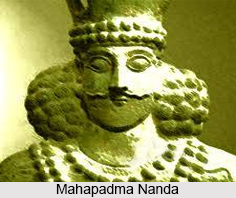 According to the Puranas, Mahapadma Nanda was the first emperor of the Nanda Empire and ruled Pataliputra from 345 to 321 BCE. The Matsya and Vayu Puranas detailed the length of his reign varying between 28 to 88 years respectively. They further stated that his eight sons ruled in succession after him. But as per the Buddhist texts contradicts the Puranas and states that the first Nanda ruler was Ugrasena.
According to the Puranas, Mahapadma Nanda was the first emperor of the Nanda Empire and ruled Pataliputra from 345 to 321 BCE. The Matsya and Vayu Puranas detailed the length of his reign varying between 28 to 88 years respectively. They further stated that his eight sons ruled in succession after him. But as per the Buddhist texts contradicts the Puranas and states that the first Nanda ruler was Ugrasena.
Life of Mahapadma Nanda
Born to the last Shaishunaga king Mahanandin and a Shudra woman, Mahapadma Nanda was also known as Mahapadmapati, which literally meant the "lord of immense wealth". Some of his other names were "ekarat" or the sole sovereign and "sarva kshatrantaka" or the destroyer of the Kshatriyas. Other than being the first Nanda ruler, Mahapadma Nanda was also the first Shudra king of Magadha and was credited with extensive conquests.
The Jain texts illustrate that Mahapadma Nanda was the son of a courtesan from a barber. This theory was further agreed by Roman historian Curtis who claims that Mahapadma"s father was originally a barber who somehow gained the queen"s affection and assassinated the king. Eventually under the pretext of acting as a guardian for the then princes, he gained authority and killed the king"s children. He produced his own and thus Mahapadma Nanda became the next Nanda king who was the contemporary of Porus and Alexander.
Following the extensive regime and demise of Mahapadma Nanda, the kingdom was assumed by Pandhuka.
This article is a stub. You can enrich by adding more information to it. Send your Write Up to content@indianetzone.com.



















